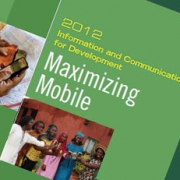“Maximizing Mobile” Report Eyes the Future of M4D
In 2008, Jeffrey Sachs said to the United Nations Millenium Project that “mobile phones and wireless internet end isolation, and will therefore prove to be the most transformative technology of economic development of our time.” Well, as the new World Bank report “Maximizing Mobile” shows, Sachs may not have been too far off the mark. However, despite the promising statistics there are still some daunting challenges in the field of m4d that must be overcome.
The report shows some very encouraging mobile statistics. Between 2000 and 2012, the number of mobile phones in use worldwide grew from less than 1 billion to over 6 billion (check out this great info-graphic). The number of mobile subscriptions in low and middle-income countries has increased by over 1,500 percent between the years 2000 and 2010, moving from 4 subscriptions per 100 people up to 72 subscriptions. Indeed, the mobile sector as a whole has become an increasingly significant economic force in developing economies, with mobile revenues as a proportion of gross national income (GNI), rising from 0.9 percent in 2000 to 1.5 percent in 2010.
Beyond statistics, the report points to some very interesting trends that must be kept in mind as we move forward in any mobile for development work. First and foremost, “Maximizing Mobile” marks a change in dynamics for the Bank’s approach to ICT: a shift away from its traditional supply-side focus on connectivity to a new demand-side focus on mobile applications and the ways ICTs are used. Indeed, the report posits that much of the industry is shifting from hardware to software and services – as it is no longer about the phone, but rather how the phones are used. Though true,
As for challenges, the report provides useful inside into the obstacles and constraints that mobile still faces. Generally, the most common constraints to the supply side of mobile service provision are a lack of available spectrum and inadequate backbone networks. The largest constraints on the demand side remain a lack of affordable mobile devices and broadband services, as well as a dearth of local applications and content available to users. The bank goes on to underscore the importance of partnership programs between government, business, and NGOs and the role they can play in surmounting these obstacles.
When it comes to content creation, no one is better placed to construct relevant and localized applications and services than those who need them. The Bank points out, quite rightly, that “new mobile applications that are designed locally and rooted in the realities of the developing world will be much better suited to addressing challenges than applications transplanted from elsewhere.” The report highlights the emerging trend of the crowdsourcing that has arisen out of social networking, increased connectivity and the subsequent demand that often results. Local content portals have been popping up all over the world in order to satisfy local demand for various types of news and information previously inaccessible. Indeed many mobile innovations (multi-sim card phones, low-cost recharges, mobile payments) increasingly originate in poorer countries.
There are many opportunities in the field as we move forward. Tapping into and fostering local talent for mobile application development is an important next step and should remain a priority, as use and development of smart phone applications is likely to rise as market pressures continue to drive down prices. Cross-sector partnerships between governments, firms, and NGOs will be necessary for creating the necessary solutions to both supply and demand-side obstacles. Sachs may very well have been correct, but we still have many challenges ahead before mobile’s full potential can be realized.






































